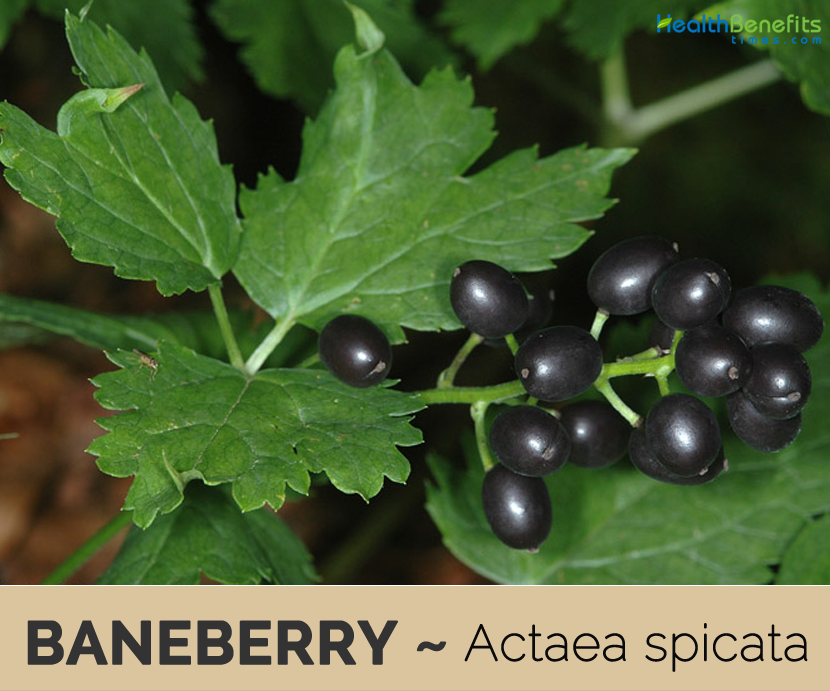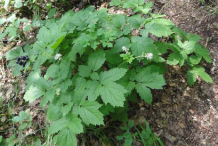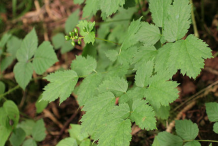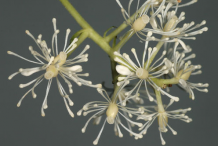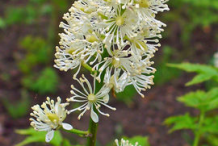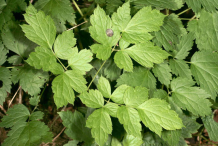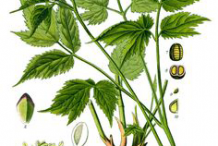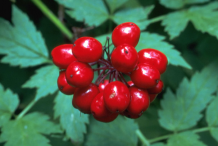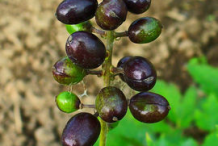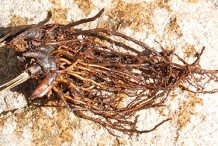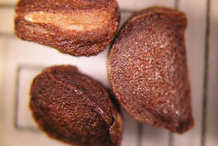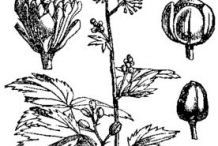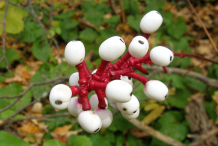Plant Description
Baneberry is a poisonous herbaceous, perennial, flowering plant that grows about 0.5 m (1ft 8in)tall and spread 0.3 m (1ft) wide. The plant is found growing in moist shady areas, mostly in deciduous forests but also in mixed coniferous forests, open pine or spruce woodlands, swales, stream banks and swamps. The plants prefer humus-rich damp, stony woods. Plant has black, creeping root-stock that is short, oblique, woody and erects shiny stems, growing 1 to 2 feet high, which are triangular and either not branched, angularly curved from nodes, base with 3–4 scales. The whole plant is dark green and glabrous (without hairs), or only very slightly downy.
Leaves
Leaves are toothed, alternate, up to 40 cm long and 30 cm broad. Basal leaves are long-stalked and stem leaves short-stalked and smaller. Blade is triangular, wider than long, darkish green, usually with 3 leaflets. Secondary leaflets are elliptic–widely ovate, with large-toothed margin, almost glabrous. Terminal leaflet base usually cordate–blunt, central lobe slightly longer than lateral lobes, tooth at tip slightly longer than margin teeth.
Flower & Fruit
The flowers are white, with 4-6 petaloid sepals, and are produced in an erect raceme about 10 cm long. Flowering normally occurs from May to June. The fruit is egg-shaped berries, black and shining, 10-11 mm long and 8 mm diameter, many-seeded and very poisonous, well justifying the popular name of Baneberry. Seeds start ripening from Jul to August.
All parts of baneberry contain poisonous compounds and sensitive people can get symptoms just from touching the stems. The berries contain cardiogenic toxins which can have an immediate sedative effect on human cardiac muscle tissue, and are the most poisonous part of the plant. Ingestion of the berries can lead to cardiac arrest and death. The berries are harmless to birds, the plants’ primary seed dispersers. The plant is of an acrid, poisonous nature throughout, and though the root has been used in some nervous cases, and is said to be a remedy for catarrh, it must be administered with great caution.
Varieties
There are two varieties of Baneberry:
Actaea spicata var. spicata. Europe, northwestern Asia; at 0-1900 m altitude
Actaea spicata var. acuminata (syn. A. acuminata). Southwestern Asia, Himalaya, at 2500-3700 m altitude
Traditional Medicinal Use of Baneberry
- Root is antispasmodic, cytostatic, emetic, nervine and purgative.
- Root is used in the treatment of snakebite in Canada.
- It is also considered useful in the treatment of nervous disorders and rheumatic fever.
- It is used in the treatment of rheumatism, goitre and asthma in India.
- Tea prepared from its leaves is a good herbal remedy for headache.
- Mixtures prepared from its roots are effectual for itchy skin.
- Bandages made from its leaves are applied on wounds.
- Roots are crushed and its mixtures are used for gargling to combat sore throat.
- Tea made from its roots is used for treating ailments like cold and cough.
- Roots decoction is a good herbal remedy for rheumatic pains.
- Mixtures made from its roots are advantageous for women suffering from Menopausal disorders and menstrual problems.
- It is consumed by lactating mothers to increase the milk flow and is a purgative after child birth.
- Tea made from the root is used as an appetizer, in the treatment of stomach pains, coughs, colds, menstrual irregularities, post-partum pains, to increase milk flow and as a purgative after childbirth.
- Tincture of the root is good for rheumatic type pains in the joints and muscles.
- Tincture can also be used to remove hot flashes.
- Black root is considered a remedy for catarrh, or inflammation of the mucus membranes.
- Plant may also work as a spasm suppressant.
- Some nervous disorder symptoms have been alleviated through its use as well.
- Some other ailments that can be treated by actaea spicata include asthma, thyroid swelling, and general rheumatism.
- Its roots are advantageous for menstrual disorders and menopause.
Other Facts
- Smell of the plant is reputed to drive away vermin.
- Black dye is obtained from the berries when alum is used as a mordant.
- It is also grown as an ornamental plant in gardens.
- Berries are probably poisonous to at least a number of mammals, but birds can happily eat them and spread their seeds.
Precautions
- Ingestion of the berries can lead to cardiac arrest and death.
- All parts of plant are poisonous but rarely fatal.
- Pregnant women and person suffering from chronic low blood pressure must avoid it.
- Taking as few as two berries can cause severe cramps, headaches, vomiting, bloody diarrhea, and/or dizziness.
- Severe proto-anemonin poisoning can lead to paralysis of the respiratory system and cardiac arrest.
References:
https://www.itis.gov/servlet/SingleRpt/SingleRpt?search_topic=TSN&search_value=184135#null
https://davesgarden.com/guides/pf/go/2348/
http://pfaf.org/user/Plant.aspx?LatinName=Actaea+spicata
https://www.botanical.com/botanical/mgmh/b/banebe11.html
http://www.theplantlist.org/tpl1.1/record/kew-2620577
http://www.popflock.com/learn?s=Actaea_spicata
https://en.wikipedia.org/wiki/Actaea_spicata
https://nutrawiki.org/actaea-spicata/
https://plants.usda.gov/core/profile?symbol=ACSP10
https://en.wikipedia.org/wiki/Actaea_(plant)
Comments
| Baneberry Quick Facts | |
|---|---|
| Name: | Baneberry |
| Scientific Name: | Actaea spicata |
| Origin | Eastern Europe and Western Asia |
| Colors | Green when young turning to Black as they ripe |
| Shapes | Egg-shaped berries, black and shining, 10-11 mm long and 8 mm diameter |
| Taste | Sweet |
| Name | Baneberry |
|---|---|
| Scientific Name | Actaea spicata |
| Native | Eastern Europe and Western Asia |
| Common Names | Baneberry, Eurasian Baneberry, Herb Christopher, Bugbane, Toadroot, Grapewort |
| Name in Other Languages | Azerbaijani: Sünbülvari qarğaotu , Sünbülvari qarğaotu Catalan: Herba de Sant Cristòfol Czech: samorostlík klasnatý, Samorostlík klasnatý Danish: Druemunke, Sort Druemunke Dutch: Christoffelkruid English: Baneberry, Toadroot, herb Christopher, Bugbane Estonian: Salu siumari Finnish: Mustakonnanmarja French: Actée en épi, Herbe aux poux German: Christophskraut, Schwarzfrüchtiges Christophskraut, Ähriges Christophskraut Hindi: Visha Phale Italian: Barba di capra Latvian: Vārpainā krauklene Nynorsk, Norwegian: Trollbær Norwegian Bokmål: Trollbær Polish: Czerniec gronkowy Portuguese: Herba de São Cristóvão Romanian: Orbalt Russian: Voronec kolosovidnyj, воронец колосовидный Spanish: Actaea spicata, hierba de San Cristóbal, Cimífuga Swedish: Mustakonnanmarja, Trolldruva Upper Sorbian: Wšědna čornica |
| Plant Growth Habit | Poisonous herbaceous, perennial, flowering plant |
| Growing Climate | Moist shady areas, mostly in deciduous forests but also in mixed coniferous forests open pine or spruce woodlands, swales, stream banks and swamps |
| Soil | Prefers a humus-rich damp, stony woods |
| Plant Size | 0.5 m (1ft 8in)tall and spread 0.3 m (1ft) wide |
| Root | Black, creeping root-stock is short, oblique, woody |
| Stem | Erect shiny stems, growing 1 to 2 feet high, which are triangular and either not branched, angularly curved from nodes, base with 3–4 scales |
| Leaf | Toothed, bipinnate compound leaves up to 40 cm long and 30 cm broad |
| Flowering Periods | May to June |
| Flower | White, with 4-6 petaloid sepals, and are produced in an erect raceme about 10 cm long |
| Fruit Shape & Size | Egg-shaped berries, black and shining, 10-11 mm long and 8 mm diameter |
| Fruit Color | Green when young turning to black as they ripe |
| Taste | Sweet |
| Plant Parts Used | Root |
| Varieties |
|
| Season | Jul to August |


